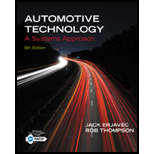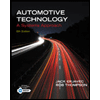
Automotive Technology: A Systems Approach (MindTap Course List)
6th Edition
ISBN: 9781133612315
Author: Jack Erjavec, Rob Thompson
Publisher: Cengage Learning
expand_more
expand_more
format_list_bulleted
Concept explainers
Textbook Question
Chapter 11, Problem 10ASRQ
Technician A says that crankshaft counterweights offset the weight of the connecting rods and pistons. Technician B says that crankshaft counterweights are used to dampen crankshaft torsional vibrations. Who is correct?
- Technician A
Expert Solution & Answer
Trending nowThis is a popular solution!

Students have asked these similar questions
Technician A says that an in-line six-cylinder diesel engine is usually longer and heavier than a V8 engine of the same displacement. Technician B says that there are twice as many teeth on the crankshaft as there are on the camshaft sprocket.
Who is correct? and why?
Technician A
Technician B
Both A and B
Neither A nor B
Technician A says that the piston seal retracts the caliper piston when hydraulic pressure is released. Technician B says that a return spring is used to retract a caliper piston. Who is correct?
Q1- Explain the duties of camshaft, distributor and alternator, which are among the engine parts
Chapter 11 Solutions
Automotive Technology: A Systems Approach (MindTap Course List)
Ch. 11 - Explain how to use a micrometer to measure cam...Ch. 11 - What is the cylinder taper?Ch. 11 - Describe how to measure main bearing oil...Ch. 11 - Where does maximum cylinder bore wear occur and...Ch. 11 - What type of valve lifter automatically...Ch. 11 - List three types of compression rings.Ch. 11 - Most pistons used today are made of. cast iron...Ch. 11 - Cam bearings in OHV engines are typically which...Ch. 11 - Which of the following is not of concern when...Ch. 11 - True or False? Cylinder taper is the difference in...
Ch. 11 - What is the purpose of a thrust main bearing?Ch. 11 - Each halt' of a split bearing is made slightly...Ch. 11 - Prob. 13RQCh. 11 - Prob. 14RQCh. 11 - Which type of oil ring is slotted so that excess...Ch. 11 - When removing the balance shaft assembly:...Ch. 11 - After installing cam bearings: Technician A checks...Ch. 11 - Technician A says that a cylinder wall with too...Ch. 11 - Technician A uses a pry bar to stretch the timing...Ch. 11 - Technician A installs a cup-type core plug with...Ch. 11 - Technician A uses a micrometer to measure the...Ch. 11 - Technician A says that piston ring end gaps should...Ch. 11 - Technician A checks crankshaft oil clearance with...Ch. 11 - When removing the piston and rod assemblies from a...Ch. 11 - Technician A says that crankshaft counterweights...
Knowledge Booster
Learn more about
Need a deep-dive on the concept behind this application? Look no further. Learn more about this topic, mechanical-engineering and related others by exploring similar questions and additional content below.Similar questions
- While installing a timing belt: Technician A installs the belt, turns the crankshaft two full rotations, then applies tension to the belt. Technician B installs the belt, applies tension, then turns the crankshaft two full rotations. Who is correct? a. Technician A b. Technician B c. Both A and B d. Neither A nor Barrow_forwardWhich of the following is probably not the cause of a vibrating clutch? a. Excessive crankshaft end play b. Out-of-balance pressure plate assembly c. Excessive flywheel runout d. Loose flywheel boltsarrow_forwardWhile discussing what affects the amount of pressure exerted by the brakes: Technician A says that the shorter the line, the more pressure there will be. Technician B says that braking force will increase if the size of the pistons in a master cylinder are increased. Who is correct? Technician A only Technician B only Both A and B Neither A nor Barrow_forward
- Which of the following is the most likely cause for a shudder during the engagement of a lock-up torque converter? a. A bad converter b. Worn or damaged CV or U-joints c. A worn front planetary gearset d. Loose flexplatearrow_forwardAll of the following are functions of the flywheel, except it ____ . a. provides a mounting place for the clutch assembly b. smooths out cylinder firing pulsations c. has marks used to set the valve timing d. meshes with the starter drive geararrow_forwardTechnician A says off-square springs may cause increased stem-to-guide wear. Technician B says excessive spring tension may cause premature camshaft wear. Who is correct? Technician A Technician B Both A and B Neither A nor Barrow_forward
- While discussing camshafts Technician A says valve lift is based only on the height of the cam lobe. Technician B says valve duration is based on the height of the lobe. Who is correct? a. Technician A b. Technician B c. Both A and B d. Neither A nor Barrow_forwardTechnician A says that delayed shifting can be caused by worn planetary gearset members. Technician B says that delayed shifts or slippage may be caused by leaking hydraulic circuits or sticking spool valves in the valve body. Who is correct? a. Technician A only b. Technician B only c. Both A and B d. Neither A nor Barrow_forwardThe connecting rod journal is also called the __ .a. balancer shaftb. vibration damperc. Plastigaged. crankpinarrow_forward
- Technician A says that the piston seal retracts the caliper piston when hydraulic pressure is released. Technician B says that a return spring is used to retract a caliper piston. Who is correct? a. Technician A only b. Technician B only c. Both A and B d. Neither A nor Barrow_forwardTrue or false Gears and crankshaft are transmitting type of short distance power type of transmissionarrow_forwardWhile diagnosing the cause of a clicking noise that is heard only when the car is turning: Technician A says that the most probable cause is a worn wheel bearing. Technician B says that the most probable cause is a worn outboard CV joint. Who is correct? a. Technician A only b. Technician B only c. Both A and B d. Neither A nor Barrow_forward
arrow_back_ios
SEE MORE QUESTIONS
arrow_forward_ios
Recommended textbooks for you
 Automotive Technology: A Systems Approach (MindTa...Mechanical EngineeringISBN:9781133612315Author:Jack Erjavec, Rob ThompsonPublisher:Cengage Learning
Automotive Technology: A Systems Approach (MindTa...Mechanical EngineeringISBN:9781133612315Author:Jack Erjavec, Rob ThompsonPublisher:Cengage Learning Automotive TechnologyMechanical EngineeringISBN:9781337794213Author:ERJAVEC, Jack.Publisher:Cengage,
Automotive TechnologyMechanical EngineeringISBN:9781337794213Author:ERJAVEC, Jack.Publisher:Cengage,

Automotive Technology: A Systems Approach (MindTa...
Mechanical Engineering
ISBN:9781133612315
Author:Jack Erjavec, Rob Thompson
Publisher:Cengage Learning

Automotive Technology
Mechanical Engineering
ISBN:9781337794213
Author:ERJAVEC, Jack.
Publisher:Cengage,
Ch 2 - 2.2.2 Forced Undamped Oscillation; Author: Benjamin Drew;https://www.youtube.com/watch?v=6Tb7Rx-bCWE;License: Standard youtube license